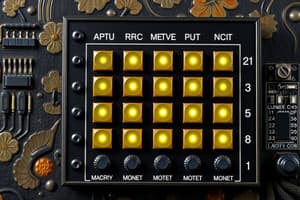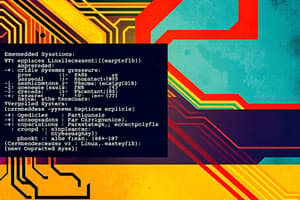Podcast
Questions and Answers
What does Dynamics refer to in the context of embedded systems?
What does Dynamics refer to in the context of embedded systems?
Dynamics refers to the capability to do actions required in a computing system. It supports all interaction with the outside world in which it passes through so called interfaces.
What are the three main functions of interfaces in embedded systems?
What are the three main functions of interfaces in embedded systems?
Interfaces establish connection between humans, environment, phenomena, and machines, thus providing input, process, or output.
What are the three levels of understanding for I/O operations in embedded systems?
What are the three levels of understanding for I/O operations in embedded systems?
I/O operations imply communicating with the device. Programming the device to initiate an I/O request. Performing actual data transfer between the device and the system.
The ______ signal rapidly switches between high and low at some fixed frequency, varying the amount of time that it holds the signal high.
The ______ signal rapidly switches between high and low at some fixed frequency, varying the amount of time that it holds the signal high.
In active-high logic, a voltage near zero represents a logical one.
In active-high logic, a voltage near zero represents a logical one.
Tristate logic allows the I/O pin to be adjusted into the off state.
Tristate logic allows the I/O pin to be adjusted into the off state.
What is the standard for connecting teletypes to modems?
What is the standard for connecting teletypes to modems?
What are the two main types of interfaces?
What are the two main types of interfaces?
Parallel interfaces typically have speeds above 1MBps.
Parallel interfaces typically have speeds above 1MBps.
What is the common standard for parallel interfaces and what type of interface does it use?
What is the common standard for parallel interfaces and what type of interface does it use?
What are the two main types of buses in embedded systems?
What are the two main types of buses in embedded systems?
What is the purpose of a module in embedded systems?
What is the purpose of a module in embedded systems?
What are the three main components of an infrared receiver?
What are the three main components of an infrared receiver?
Bluetooth wireless technology operates in the ISM band from 2.4 to 2.485 GHz.
Bluetooth wireless technology operates in the ISM band from 2.4 to 2.485 GHz.
What are the two main purposes of a GSM/GPRS module?
What are the two main purposes of a GSM/GPRS module?
Wi-Fi is an Ethernet replacement.
Wi-Fi is an Ethernet replacement.
What are the advantages of wireless technology?
What are the advantages of wireless technology?
What is the purpose of an interrupt in embedded systems?
What is the purpose of an interrupt in embedded systems?
What is the main difference between an interrupt and an exception?
What is the main difference between an interrupt and an exception?
Atomic operations are guaranteed to complete without being interrupted by other events.
Atomic operations are guaranteed to complete without being interrupted by other events.
What is the purpose of an interrupt controller in embedded systems?
What is the purpose of an interrupt controller in embedded systems?
Flashcards
Embedded Systems Dynamics
Embedded Systems Dynamics
The ability of embedded systems to perform actions required in a computing system, supporting interactions with the outside world.
Interfaces
Interfaces
Establish connections between humans, environment, phenomena, and machines, providing input, processing, or output.
I/O Operations
I/O Operations
Input/Output operations; communicating with devices, programming them, and transferring data.
Pulse Width Modulation (PWM)
Pulse Width Modulation (PWM)
Signup and view all the flashcards
General-Purpose Digital I/O
General-Purpose Digital I/O
Signup and view all the flashcards
Serial Interfaces
Serial Interfaces
Signup and view all the flashcards
RS-232
RS-232
Signup and view all the flashcards
Transmission Rate
Transmission Rate
Signup and view all the flashcards
Start Bit
Start Bit
Signup and view all the flashcards
Stop Bit
Stop Bit
Signup and view all the flashcards
USB
USB
Signup and view all the flashcards
Plug-and-Play
Plug-and-Play
Signup and view all the flashcards
JTAG
JTAG
Signup and view all the flashcards
Parallel Interfaces
Parallel Interfaces
Signup and view all the flashcards
IEEE-1284
IEEE-1284
Signup and view all the flashcards
Study Notes
Interfaces and Mechanisms
- Embedded systems integrate computing and physical actions, interacting with the outside world via interfaces.
- Interfaces connect humans, the environment, phenomena, and machines, enabling input, processing, and output.
- Physical I/O interfaces handle input/output operations, requiring knowledge of hardware details like programming the device and data transfer.
- Pulse Width Modulation (PWM) efficiently delivers variable power to devices by rapidly switching between high and low voltage levels at a fixed frequency.
- General-Purpose Digital I/O allows software to read or write voltage levels (high or low), representing logical 1 or 0, for outputs or inputs.
- Serial interfaces sequentially transmit bits over a single wire, efficiently using pins and wires.
- RS-232, a standardized serial interface protocol created by EIA, is used to connect teletypes to modems, with slower transmission rates.
Common I/O Interfaces
- Mechanism: The sender and receiver agree on a transmission rate. The sender sends a start bit, followed by data bits, and one or two stop bits. The receiver's clock synchronizes with the sender's to recover the bit sequence.
- USB (Universal Serial Bus) enhances plug-and-play functionality for peripheral devices, allowing hot-swapping.
- Joint Test Action Group (JTAG) or IEEE 1149.1, a boundary-scan architecture, is a testing interface for circuits.
Parallel Interfaces
- Parallel interfaces use multiple lines to transmit bits simultaneously.
- IEEE-1284 is a parallel printer interface specification with bi-directional, asynchronous communication at speeds exceeding 1MBps.
- Buses enable communication among multiple devices in contrast to point-to-point interconnections.
I/O Modules
- I/O modules are collections of electrical components designed for a particular function.
- They handle specifics depending on the type of input/output interface and how they are used as requirements.
- Modules handle errors and exceptions. They are also flexible with new or old applications based on need.
- Examples of wireless I/O modules include Infrared (IR) transmitters/receivers, Bluetooth, Global System for Mobile Communications (GSM) and General Packet Radio Service (GPRS) modules, and Wi-Fi.
Interrupts and Exceptions
- Interrupts: A mechanism pausing a processor's current task to execute pre-defined code (Interrupt Service Routine-ISR). This handles incoming hardware or software requests, or exceptions.
- Hardware Interrupts: External hardware signals cause a voltage change on an interrupt request line.
- Software Interrupts: The program triggers the interrupt by executing specific instructions or writing to memory registers.
- Exceptions: Interrupts triggered by internal hardware faults such as segmentation faults.
- Programmable Interval Timer (PIT): A PIT is a hardware component that counts down from a set value and generates an interrupt when the value reaches zero.
Studying That Suits You
Use AI to generate personalized quizzes and flashcards to suit your learning preferences.




